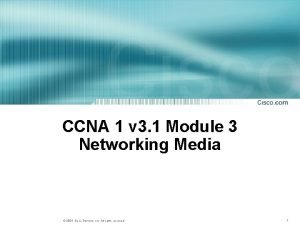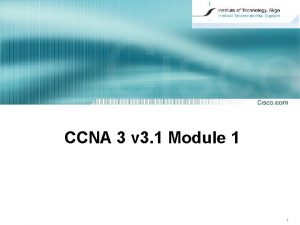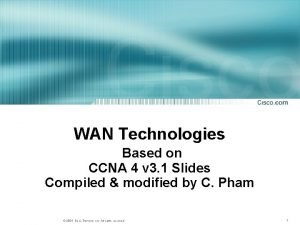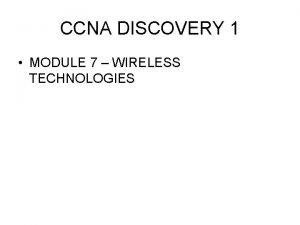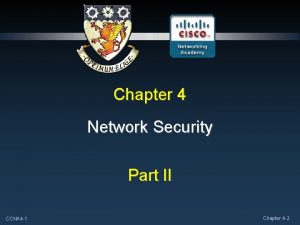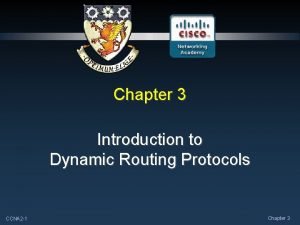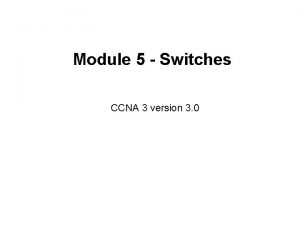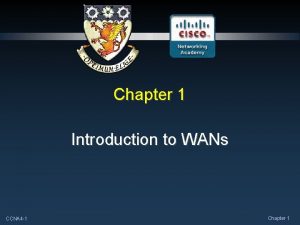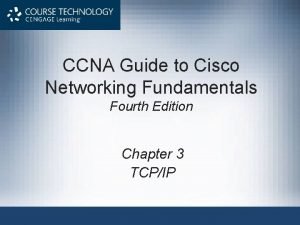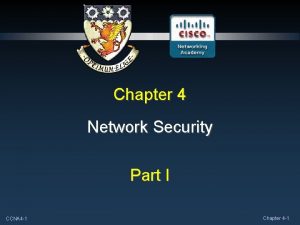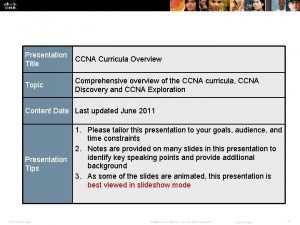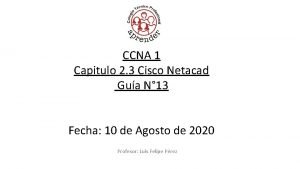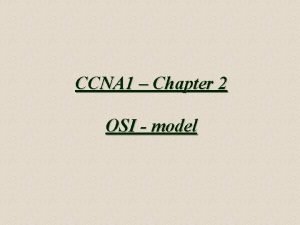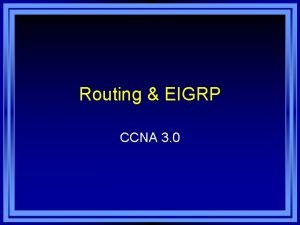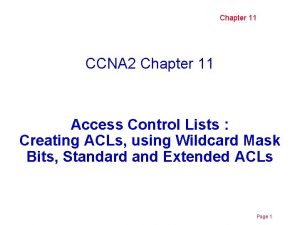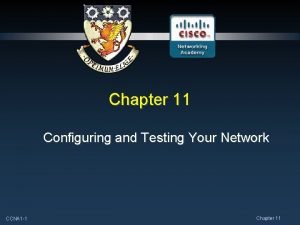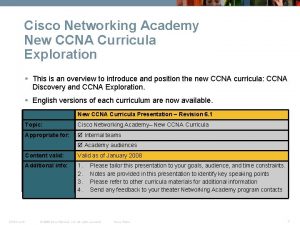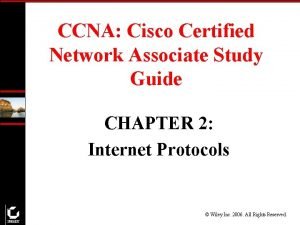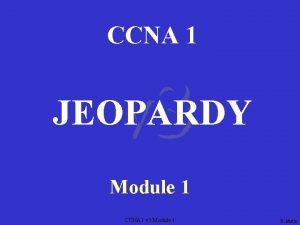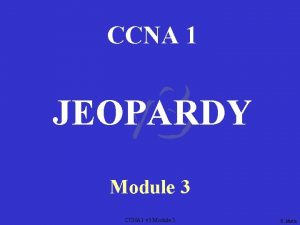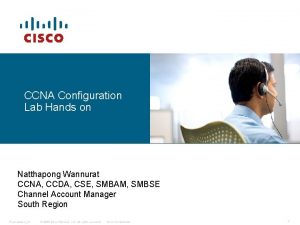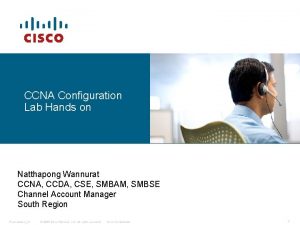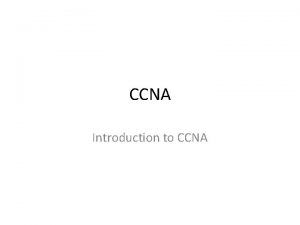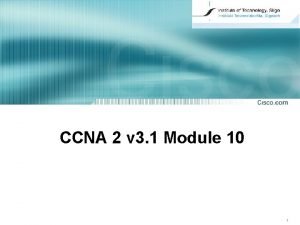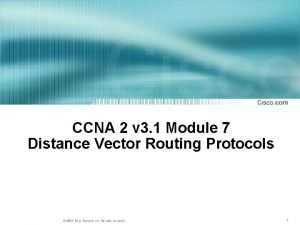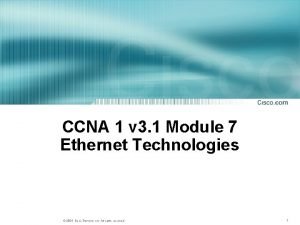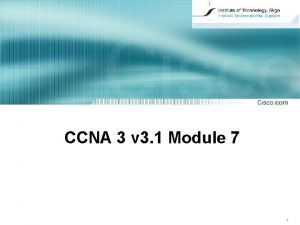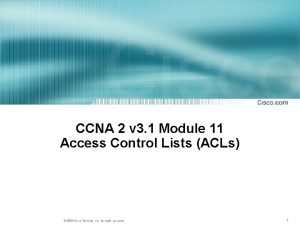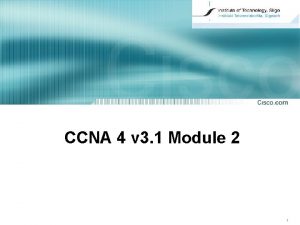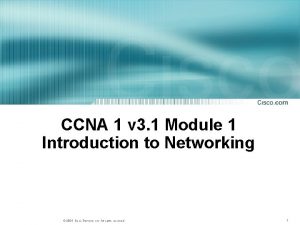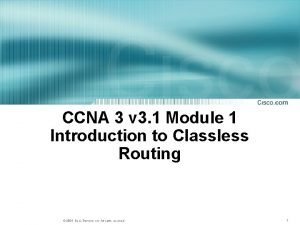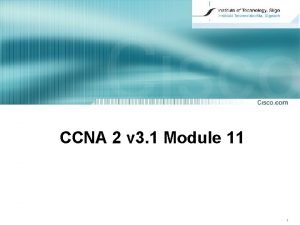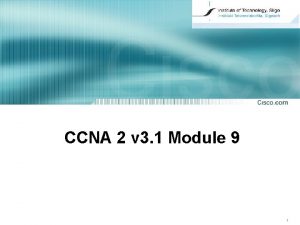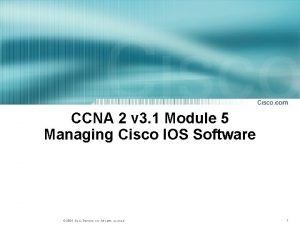CCNA 3 v 3 1 Module 1 1


























- Slides: 26

CCNA 3 v 3. 1 Module 1 1

CCNA 3 Module 1 Introduction to Classless Routing 2

Classfull Routing • IP V 4 – class A, B, C • Limited number of unique network addresses • No subnet information sent in routing • A single network must use the same subnet mask Network 192. 168. 187. 0 - 255. 0 • Classful routing protocols Cannot support Variable Length Subnet Mask (VLSM) RIP V 1, IGRP, EGP, BGP 3 • WAN and LAN links have the same Number of bits in subnet mask Number of possible hosts 3

IPv 4 Address Classes • No medium size host networks • In the early days of the Internet, IP addresses were allocated to organizations based on request rather than actual need. 4

IPv 4 Address Classes Class D Addresses • A Class D address begins with binary 1110 in the first octet • First octet range 224 to 239 • Class D address can be used to represent a group of hosts called a host group, or multicast group Class E Addresses • First octet of an IP address begins with 1111 • Class E addresses are reserved for experimental purposes and should not be used for addressing hosts or multicast groups 5

IP Addressing CRISIS • Address Depletion – shortage of ip addresses • Internet Routing Table Explosion – increase in the size of internet routing tables 6

A Waste of Space 7

Class C Address • LAN link has 28 -2 = 254 possible hosts • WAN link has 28 -2 = 254 possible hosts WAN link only needs 2 hosts IPv 6 252 wasted host addresses • 128 bit address space • Possible addresses 2128 -2 340, 283, 366, 920, 938, 463, 374, 670, 431, 768, 211, 456 8

Variable Length Subnet Mask? • Short term extensions to IPv 4 • Subnetting 1985 • Variable length subnetting 1987 • Classless Interdomain Routing 1993 • Allows for route aggregation and suppernetting • Private IP addresses • Network Address Translation (NAT) 9

Routing protocols that all Classless routing • Can have a variable length subnet mask • Protocols OSPF EIGRP IS-IS RIP V 2 Static Routing BGP 4 10

Route Aggregation with VLSM Summarisation • Represents a collection of IP Addresses within a Single IP Address • Place networks close to one another to save routing table space keeping networks like 172. 16. 14. 0 and 172. 16. 15. 0 near one another so that the routers need only carry a route for 172. 16. 14. 0/23 Without this the internet backbone would collapse • Route summarization (or supernetting) only possible if the routers run a classless routing protocol E. g. s OSPF and IS-IS 11

Aggregation Rules • A router must know in detail the subnet numbers attached to it • A router does not need to tell other routers about each individual subnet if the router can send one aggregate route for a set of routers • A router using aggregate routes would have fewer entries in its routing table 12

• VLSM allows for the summarization of routes and increases flexibly • Bases summarization entirely on the higher-order bits shared on the left 13

variable-sized networks / subnetworks is summarized at various points using a prefix address until the entire network is advertised as a single aggregate route 14

What is a VLSM? • Variable Length Subnet Mask Use address space more efficiently Use a long mask on networks with few hosts Use a short mask on subnets with many hosts 15

• VLSM allows a single autonomous system to have networks with different subnet masks a 30 -bit subnet mask on network connections 255. 252 for networks with 2 nodes Used for point-to-point connections a 24 -bit mask for user networks 255. 0 for networks up to 252 users Wasteful for point-to-point networks even a 22 -bit mask for user networks 255. 252. 0 for networks with up to 1000 users • Do a class example 16

• When designing an addressing scheme When to use VLSM should allows for growth not involve wasting addresses • VLSM helps to manage IP Addresses Set subnet mask to suit the link or the segment requirements • To prevent waste of addresses use VLSM Large subnets Created for addressing LANs Very small subnets A 30 -bit mask for subnets with only 2 valid host addresses For a point-to-point connection For WAN links 17

First and Last Subnet Mask • Previously it was recommended not to use First subnet – zero subnet – network address Last subnet - all-ones subnet – broadcast address • VLSM allows first and last subnets to be used If management decides to use subnet zero, it has 8 useable subnets ip subnet-zero If management decide not to use subnet 0 – 7 useable subnets no ip subnet-zero 18

• Distance vector protocol • Broadcasts entire routing table to each neighbor router • Broadcasts at intervals of 30 seconds • Metric is hop count • Classful routing – Class A, B, C • Prevents routing loops using RIP V 1 Maximum hop count – maximum 15 hops – after that packet is dropped Split horizon – don’t teach the teacher Holddown timers – ignore poorer metric information for 180 seconds • Popularity is based on Simplicity and Load balancing over 6 equal-cost paths (4 paths default) • Limitations: It does not send subnet mask information in its updates It sends updates as broadcasts on 255. It does not support authentication It is not able to support VLSM or classless interdomain routing (CIDR) • Configuration 19

• Distance vector protocol • Metric is hop count RIP V 2 • Prevents routing loops using Uses a hop count metric- max 15 - 16 hops for infinite distance Uses holddown timers to prevent routing loops – default 180 sec It uses split horizon to prevent routing loops • Provides prefix routing Send out subnet mask information with route update • Supports classless routing (VLSM) Different subnetworks can use different subnet masks • Provides for authentication in its updates Clear text authentication key is the default Message-Digest 5 (MD 5) encryption Used to authenticate the source of a routing update • It multicasts routing updates Send routing updates to 224. 0. 0. 9 instead of 255 20

Configuring RIP Version 2 • Router(config)#router rip • Router(config-router)#version 2 • Router(config-router)#network <network no> 21

erify RIP V 2 with show ip protocols 22

Verifying Rip V 2 using show ip route 23

Other verifications for RIP V 2 • Show ip interface brief • Show running-config • Show ip protocols 24

Troubleshooting RIP V 2 • debug ip rip Displays rip routing updates as they are sent/recieved • No debug all Turns off debugging 25

Default Routes • By default, routers learn paths to destinations three different ways: • Static routes – System administrator manually defines the static routes as the next hop to a destination - useful for security and traffic reduction, as no other route is known. ip route <destination network> <subnet mask> <next hop> • Default routes – System administrator manually defines default routes as the path to take when there is no known route to the destination - keep routing tables shorter ip route 0. 0 <next hop> • Dynamic routes – Router learns of paths to destinations by receiving periodic updates from other routers ip default-network <default network number> All the packets that are not defined in the routing table will go to 26 the nominated interface of the default router
 Ccna module 3
Ccna module 3 Ccna module 3
Ccna module 3 Ccna module 1
Ccna module 1 C device module module 1
C device module module 1 Wan technologies ccna
Wan technologies ccna Ccna discovery 1
Ccna discovery 1 Ccna 4 chapter 4
Ccna 4 chapter 4 Ccna 2 chapter 3
Ccna 2 chapter 3 Ccna 3 chapter 1
Ccna 3 chapter 1 Ccna 5
Ccna 5 Ccna 4 chapter 1
Ccna 4 chapter 1 Ccna guide to cisco networking
Ccna guide to cisco networking Ccna
Ccna Ccna 4 chapter 4
Ccna 4 chapter 4 Ccna
Ccna Netacad
Netacad Ccna roadmap
Ccna roadmap Osi model ccna
Osi model ccna Eigrp ccna
Eigrp ccna Ccna chapter 11
Ccna chapter 11 Ccna 200-301 slides
Ccna 200-301 slides Ccna chapter 11
Ccna chapter 11 Cisco ccna exploration
Cisco ccna exploration Ccna voice 640-461 pdf
Ccna voice 640-461 pdf Ccna exploration 4
Ccna exploration 4 Ccna
Ccna Ccna
Ccna

